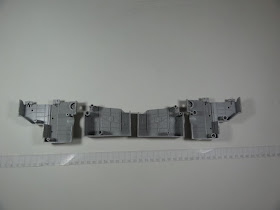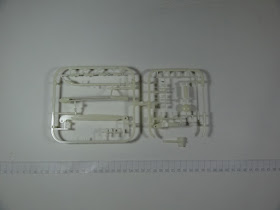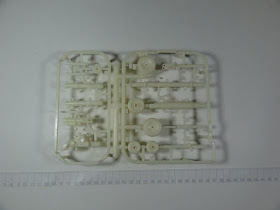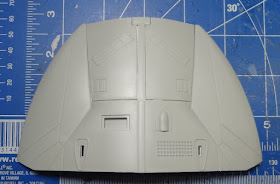Subject:
|
McDonnell-Douglas AV-8B Harrier II Plus
|
Scale:
|
1/18
|
Manufacturer:
| Hobby Boss |
Price
|
US$ 120,00 plus shipping
|
Description
|
Injected plastic model with waterslide decals and vinyl tires and some other details
|
Comments
|
This is U.S. Marines' AV-8B Harrier II Plus from Hobby Boss in the gigantic scale of 1/18. If you like big kits, this one is for you. With more then 80cm long and a wingspan of more then 50cm, you will need a lot of space to store it in your collection.
The question is: is it worth the investment? That depends on your expectations. What are you looking for? A super detailed kit out of the box like those Trumpeter and Hobby Boss kits in 1/32 or 1/48 scale? Well, you will get disappointed with this one. This kit has less parts then Hasegawa's 1/48 scale model of the same subject. Actually, if you look at Hasegawa's 1/72 scale AV-8B Harrier II Plus, you will see several similarities with Hobby Boss 1/18 scale kit. However, if you are looking for a base to start a super detailed Harrier, the basics are here, but get ready for some hard work. Finally, if you just want to have fun, build a big kit and end up with a good looking Harrier, this is a good subject for your modelling expectations. The kit comes very well packed in sturdy box. There are three other boxes inside to store and protect the parts. Remember that you are dealing with a huge kit. All major sub assemblies are made of large parts too. All is packed in plastic bags with the small parts still on the sprues, the rest coming detached and store inside the small boxes. Instructions are typical hobby Boss stuff. The exploded diagram for building the kit is divided in 31 steps and are easy to follow. Decals are provided for two versions, with the same basic painting scheme, but different squadron markings: VMA 211 and VMA 231. As usual , the markings are nicely printed and in perfect register. My kit arrived just this week as i was finishing my latest project. It went strait to the workbench. I will post the construction steps here on the blog. So stay tuned if you are thinking about getting one of these monsters for your collection! |
1) The box and the stored parts:
2) The instructions and painting guide:
3) The kit's parts: the scale bellow the parts in all the pictures is in centimeters.
4) The decals:
Test of the fit of the parts: Fit is very good around the nose section and radome. No putty was necessary here.
Ejection marks: There are several sink marks to deal with. Here is an important one around the intake.
Vinyl parts: Did i mentioned that i hate vinyl parts? The wheels and parts of the ejection seat are made of these rubberish material. I decided to cast resin copies of these parts to improve the final result.
However, there are so little details on the seat that more was needed to improve it.
Seat belts made of Tamiya masking tape, painted with Vallejo acrylics improved the final result.
I also used some nuts and bolts from Meng to increase the level of detail. Here you see the final result.
All the tires are also made of Vinyl. So, as i was already working with resin copies, i went on and made five new tires so i can put the rubber parts on the trash can.
The front wheel well has some internal detail, although i don't know if it is accurate. I painted it white and used my favorite technique for weathering: after a coat of white, i highlight the structural details with a sharp 0,3 mm pencil. Then, i airbrush some Tamiya smoke around the details. Finally, the details are hand painted with Vallejo flat white. This gives the details some depth while still keeping the basic color. Below, you see on the left the completed weathering process.
Some other details were also painted with Vallejo acrylics.
For the final touch, i used some decal stencils from my spare box.
The landing gear needs to be placed in the well before assembly. So i painted it white, highlighted the details with my 0,3 mm pencil and a wash with Mig products and applied some stencils from my spare box.
The engine intake is a structural part for the fuselage construction. I painted it white and the compressor received a coat of Tamiya XF56 metallic grey.
The engine is represented in the kit but, to display it, some major scratch building would be necessary. So i just build it as a part of the fuselage. When ready, only the intake will be visible.
The cockpit was painted dark grey, close to neutral grey. The details were picked up with my sharp pencil and Mig productions dark wash.
The small details were painted using Vallejo acrylics.
Here i made a test fit of the ejection seat.
The front fuselage was glued together with the front wheel well and the cockpit in place.
Here you see another test fit of the rest of the cockpit components.
Then i started the fuselage parts. Here you have both engine access panels. Once in place, the are supposed to be left free to open so you can see the engine. I decided to close both.
To increase the strength, i used some plasticard glued to the bottom of both parts
The problem is that the fit of the parts is not very good. Here you see some huge gaps around the doors. So is used stretched sprue glued with Tamiya extra thin cement to close the gaps.
Here is the final result. To the left, you have the door glued to the fuselage part. To the right you see the access panel with the stretched sprue applied to fill the gaps.






























































